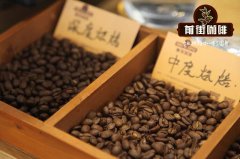Coffee roasting degree how to judge roasting degree from sound, color and aroma how to choose roasting degree

Professional coffee knowledge exchange more coffee bean information please follow the coffee workshop (Wechat official account cafe_style)
In Taiwan, drinking coffee has become an indispensable enjoyment, and more and more people choose to make coffee at home, not only for interest, but also for better coffee quality. If you have, or are planning to do, then the first thing you need to know is: good coffee comes from high-quality coffee beans.
This is the same as most food. A fish that is not fresh, no matter how gorgeous it is to cook, must not be very delicious, but a fresh fish, steamed with ginger, is very delicious. The same is true of coffee, poor quality coffee beans, no matter how good brewing skills or utensils can not be saved, destined to only make bad coffee.
So, what are high-quality coffee beans? Recall that you have had coffee that tastes good in the past, which probably has two characteristics: first, it has a charming aroma, and second, it tastes good. Different varieties of coffee beans have different tastes, and personal preferences vary, of course, but the so-called high-quality coffee beans should be able to retain the aroma and flavor of the coffee as much as possible and emit it completely when it is brewed.
1. when studying the roasting degree of coffee beans, the roasting degree of coffee can be judged by sound, color and aroma.
Its color from light gray to dark brown, aroma from light and elegant gradually rich; the sound is issued twice burst sound, for example, heat-resistant raw beans, about 7 points began the first explosion, lasting about 2 minutes, its voice is low, indicating the beginning of pyrolysis, starch into caramel, water evaporation, exhaust, around 12 minutes issued a second explosion, the sound is violent and sharp, indicating that the cell fiber is broken, the deeper the baking. (rule of thumb)
Second, the value of caramel analysis (AGTRON NUMBER) to determine the roasting degree of coffee.
The famous American Fine Coffee Association (SCAA) promotes the determination method with red inner line, whose value is from 0 to 100. the higher the value, the lower the caramelization, the grayish color and the lighter the baking. on the contrary, the lower the value, the higher the caramelization, the brighter the color, and the deeper the baking. (digitized)
III. American terminology coffee roasting degree
The most well-known roasting degree of coffee is shallow roasting, medium roasting and deep (heavy) roasting, which can be subdivided into eight stages, and the difference of roasting degree varies with different regions. The following is a brief introduction of roasting degree and flavor:
Coffee roasting degree, bean time, coffee bean appearance and flavor
Very light baking (light roast) before and after the explosion of cinnamon with a strong grass flavor, taste and aroma is not enough, often used for experiments, less for taste.
Light roasting (cinnamon roast) burst to dense cinnamon color with high acidity, grass flavor has been removed, slightly fragrant, acidity is obvious, often used to make American coffee.
From medium roast to the end, the chestnut color is light, sour and bitter, and the aroma is moderate. It retains the original flavor of coffee beans and is often used as American coffee or mixed coffee.
At the end of the first burst of moderate micro-deep baking (high roast), the reddish brown taste is rich, light, sour and bitter balanced and slightly sweet, not irritating, and the aroma and flavor is uniform.
After the first burst of medium and deep baking (city roast), the first and second bursts are light brown.
The acidity is lower than that of moderate micro-deep roasting, the taste is bright and lively, the acidity between sour and bitter balance is light, and the high-quality flavor of coffee is good, which is the standard roasting degree. It is the most popular among the general public and is often used in French coffee.
Micro-depth roasting (full city roast) the second burst brown taste is calm and full, the bitter taste is stronger than the sour taste, the aftertaste is sweet, the aroma is full, it is used to make iced coffee or black coffee. It is a common baking method in Central and South America.
Deep baking (French roast) second explosion dense to the end of the second explosion dark brown with black
Strong taste, strong bitter taste, light sour taste, almost no feeling, with strong chocolate and smoky aromas, commonly used in coffee Olei, Viennese coffee and so on.
The second explosion of extremely deep baking (Italian roas, dark roastt) ends until the bean surface turns black and glossy.
Before carbonation, coffee bean fiber has a strong, complex and bitter taste, with strong roasting and scorching aroma. It is mainly popular in Latin countries and Italy. Espresso Espresso is commonly used.
Important Notice :
前街咖啡 FrontStreet Coffee has moved to new addredd:
FrontStreet Coffee Address: 315,Donghua East Road,GuangZhou
Tel:020 38364473
- Prev

Can you drink coffee with different roasting degrees? the effect of coffee roasting degree on coffee aroma
Professional coffee knowledge exchange more coffee bean information Please pay attention to the aroma of coffee in the coffee workshop (Wechat official account cafe_style). The aroma and taste of coffee comes from the roasting degree of coffee, which is produced after roasting. In the process of baking, the moisture of raw coffee beans is slowly released, the weight is reduced, the color deepens, the volume expands, and the aromatic oil is slowly released. This
- Next

Don't throw away expired coffee beans! Teach you recycling tips that are environmentally friendly and easy to use
Professional coffee knowledge exchange more coffee bean information Please follow the coffee workshop (Wechat official account cafe_style) some friends may have this problem: coffee beans have passed their shelf life and cannot be consumed due to their long shelf life. It's a pity to throw it away, so what's the use of expired coffee beans? Today, the editor will introduce several uses for you. Overdue
Related
- Beginners will see the "Coffee pull flower" guide!
- What is the difference between ice blog purified milk and ordinary milk coffee?
- Why is the Philippines the largest producer of crops in Liberia?
- For coffee extraction, should the fine powder be retained?
- How does extracted espresso fill pressed powder? How much strength does it take to press the powder?
- How to make jasmine cold extract coffee? Is the jasmine + latte good?
- Will this little toy really make the coffee taste better? How does Lily Drip affect coffee extraction?
- Will the action of slapping the filter cup also affect coffee extraction?
- What's the difference between powder-to-water ratio and powder-to-liquid ratio?
- What is the Ethiopian local species? What does it have to do with Heirloom native species?

